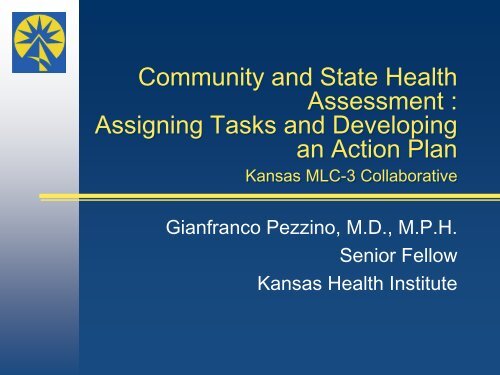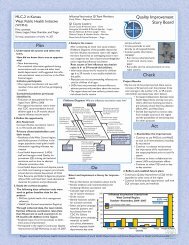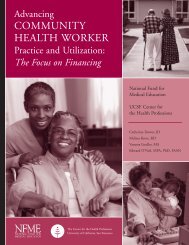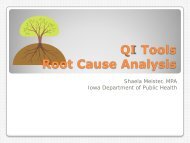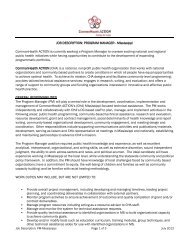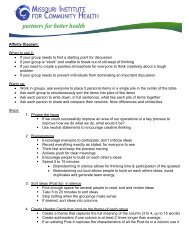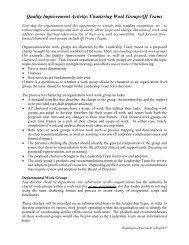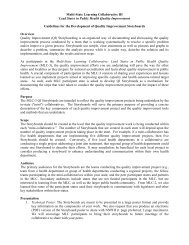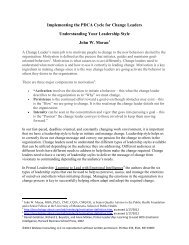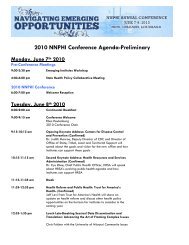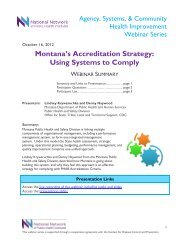CHA: Setting Priorities, Assigning Roles, and Developing Action Plans
CHA: Setting Priorities, Assigning Roles, and Developing Action Plans
CHA: Setting Priorities, Assigning Roles, and Developing Action Plans
Create successful ePaper yourself
Turn your PDF publications into a flip-book with our unique Google optimized e-Paper software.
Community <strong>and</strong> State Health<br />
Assessment :<br />
<strong>Assigning</strong> Tasks <strong>and</strong> <strong>Developing</strong><br />
an <strong>Action</strong> Plan<br />
Kansas MLC-3 Collaborative<br />
Gianfranco Pezzino, M.D., M.P.H.<br />
Senior Fellow<br />
Kansas Health Institute
Community Health Assessment<br />
L.S. 1 <strong>and</strong> A.P. 1 L.S. 2 <strong>and</strong> A.P. 2<br />
• Community public health issues<br />
• Test of gathering community input<br />
• Priority settings<br />
MLC-3 collaborative
The Logical Sequence of Steps<br />
1. <strong>Setting</strong> priorities<br />
2. Formulate goals <strong>and</strong> strategies<br />
3. Assign roles<br />
4. Develop action plan<br />
• Steps 1 through 3 require<br />
considerable community involvement<br />
• Step 4 is agency-specific, but make<br />
sure that action plans are coordinated
Disclaimer<br />
• We will discuss how to perform tasks<br />
during a community or state health<br />
assessment<br />
• These task will not all be practiced<br />
during the MLC-e project
1. <strong>Setting</strong> priorities<br />
Product: A list of community health issues<br />
that are considered priorities
Recap - Priority <strong>Setting</strong> Tools<br />
• There are a number of different tools which assist<br />
in priority setting<br />
• A tool as simple as a questionnaire or survey completed<br />
by partners <strong>and</strong>/or public to help clarify health priorities<br />
<strong>and</strong> potential strategies. Focus groups & key informant<br />
interviews may be used<br />
• Asset mapping<br />
• Prioritization matrices , some of which are covered in the<br />
memory jogger, or priority setting worksheets
Recap – Example: Priority <strong>Setting</strong><br />
Worksheets<br />
• Priority setting worksheets can include multiple criteria<br />
Example Criteria:<br />
3. Priority <strong>Setting</strong> Worksheets<br />
• Prevalence<br />
• Mortality rate<br />
• Community/Public concern<br />
• Lost productivity (bed-disability days)<br />
• Premature mortality (years of potential life lost)<br />
• Medical costs to treat or community economic costs)<br />
• Feasibility to prevent<br />
• Ability to Evaluate<br />
• Size of problem (how many people with health problem)<br />
• Seriousness of health problem<br />
• Community characteristics that support or inhibit health <strong>and</strong> healthy living<br />
• Existing state, community <strong>and</strong>/or health department priorities
Priority <strong>Setting</strong>: Possible<br />
Criteria<br />
• How widespread is the issue<br />
• How severe is it<br />
• How preventable<br />
• Are there “best practices” available<br />
• What is the degree of control of P.H.<br />
system over the issue<br />
• What is the level of public concern
Priority <strong>Setting</strong>: Additional<br />
Criteria<br />
• What happens if issue is not<br />
addressed<br />
• How related is the issue to the<br />
success of the P.H. agency/system<br />
<strong>and</strong> its vision <strong>and</strong> mission<br />
• Which issues related to the community<br />
health assessment must be addressed<br />
to achieve the vision <strong>and</strong> mission<br />
• Link back to strategic plan
Example<br />
• Vision: Health People in Healthy<br />
Communities. As a community of<br />
professionals who, through a<br />
commitment to education, innovation,<br />
leadership in crises, respect for our<br />
citizens <strong>and</strong> research solutions for<br />
health problems, we strive to make<br />
XXX County residents the healthiest<br />
people in the nation.
Example<br />
• Vision: Health People in Healthy<br />
Communities.<br />
• Mission: Promote Physical <strong>and</strong><br />
Mental Health <strong>and</strong> Prevent Disease,<br />
Injury, <strong>and</strong> Disability. Working<br />
together <strong>and</strong> committed to excellence,<br />
we protect <strong>and</strong> promote the health of<br />
our citizens through prevention,<br />
science, <strong>and</strong> the assurance of quality<br />
health care delivery.
Example<br />
• Vision: Health People in Healthy<br />
Communities.<br />
• Mission: Promote Physical <strong>and</strong> Mental<br />
Health <strong>and</strong> Prevent Disease, Injury, <strong>and</strong><br />
Disability.<br />
• Public Health issues:<br />
*Children in poverty<br />
*High school drop out rate<br />
*High teen pregnancy rates<br />
*Poor housing structures<br />
*High STDs rates
Example<br />
• Vision: Health People in Healthy<br />
Communities.<br />
• Mission: Promote Physical <strong>and</strong> Mental<br />
Health <strong>and</strong> Prevent Disease, Injury, <strong>and</strong><br />
Disability.<br />
• Public Health issues:<br />
*Children poverty<br />
*High school drop out rate<br />
*High teen pregnancy rates<br />
*Poor housing structures<br />
*High STDs rates
2. Formulate goals <strong>and</strong><br />
strategies<br />
Product: A list of goals <strong>and</strong> strategies for<br />
each priority health issue
Definitions<br />
• Goal = a common direction <strong>and</strong><br />
underst<strong>and</strong>ing of the anticipated end<br />
result<br />
• Strategies = how the community will<br />
move towards the goals
<strong>Developing</strong> Goals <strong>and</strong><br />
Strategies<br />
• Develop goals related to vision -<br />
mission - priority health issues<br />
• Examine each health issue separately<br />
• Develop goal<br />
• Develop possible strategies for<br />
achieving the goal<br />
• Select strategy (or strategies) to<br />
implement
Selection of Strategies<br />
• Can select multiple strategies for same issue<br />
• Consider barriers to implementation <strong>and</strong><br />
implementation details<br />
• Full plan of action is developed later<br />
• How long before strategy can achieve results<br />
• Try to include at least some strategies with short term<br />
outcomes<br />
• Build upon strategies that have worked (“best<br />
practices”, successful projects, etc.)<br />
• Look for strategies that can support multiple goals
Selection of Strategies – The<br />
PEARL Criteria<br />
• Propriety — Is a strategy consistent with the Essential Services<br />
<strong>and</strong> public health principles<br />
• Economics — Is the strategy financially feasible Does it make<br />
economic sense to apply this strategy<br />
• Acceptability — Will the stakeholders <strong>and</strong> the community accept<br />
the strategy<br />
• Resources — Is funding likely to be available to apply this<br />
strategy Are organizations able to offer personnel time <strong>and</strong><br />
expertise or space needed to implement this strategy<br />
• Legality — Do current laws allow the strategy to be<br />
implemented<br />
Source: Achieving Healthier Communities through MAPP:A Users H<strong>and</strong>book
Example<br />
• Vision: Health People in Healthy Communities.<br />
• Mission: Promote Physical <strong>and</strong> Mental Health <strong>and</strong> Prevent<br />
Disease, Injury, <strong>and</strong> Disability.<br />
• Public Health priority issue:<br />
• High teen pregnancy rates have increased in the past five years due to<br />
early onset of teen sexual behaviors <strong>and</strong> unsafe sexual practices<br />
• Goal: Decrease high teen pregnancy<br />
• Possible strategies:<br />
• Health education in schools<br />
• Enhanced family planning clinics<br />
• Parental education: how to “talk” to your teen<br />
• Integration of family planning <strong>and</strong> STD services<br />
• Increase in bilingual staff
3. Assign roles<br />
Products: 1. A list of who will address each<br />
community priority health issue 2. A list of<br />
priorities for the public health department
<strong>Assigning</strong> <strong>Roles</strong> - Options<br />
• LHD will provide ongoing<br />
services/activities<br />
• LHD will provide new services/activities<br />
• LHD cannot address at this time<br />
• Another organization is/will address<br />
• Consider option to address at regional<br />
level<br />
• Consider capacity<br />
• Importance of capacity assessments
<strong>Assigning</strong> <strong>Roles</strong> - Example<br />
Strategy LHD role OTHERS - Role<br />
Health education in<br />
schools<br />
Will support<br />
School district will lead<br />
Enhanced family<br />
planning clinics<br />
Will start service<br />
Community Health Clinic<br />
will exp<strong>and</strong> service<br />
Parental education: how<br />
to “talk” to your teen<br />
Will support<br />
Public library will conduct<br />
sessions<br />
Integration of family<br />
planning <strong>and</strong> STD<br />
services<br />
Will do<br />
Community Health Clinic<br />
will do<br />
Increase in bilingual<br />
staff<br />
Will exp<strong>and</strong><br />
Community Health Clinic<br />
<strong>and</strong> Hospital will exp<strong>and</strong>
4. Develop action plan<br />
Product: A plan of action for each of the health<br />
issues being addressed
Introduction to <strong>Action</strong> Plan<br />
• <strong>Action</strong> (or improvement) plan is<br />
ultimate reason for doing a<br />
community health assessment
Characteristics of <strong>Action</strong> Plan<br />
• Agency- <strong>and</strong> issue- specific<br />
• One action plan for each issue in each agency<br />
• Assure coordination with other agencies<br />
• Detailed:<br />
• Consider appointing oversight committee with<br />
community representation<br />
• Who, what, when, how<br />
• Include measurable objectives, evaluation<br />
plan<br />
• Review results periodically, adjust plan<br />
• PDSA
Community health issue:<br />
Rising STD rates <strong>and</strong> consistently high teen pregnancy/unintended pregnancy rates due to early <strong>and</strong><br />
unsafe sexual practices.<br />
What about this community health issue<br />
needs improvement<br />
County Public Health does not have an in-house family planning program. There is a local Planned<br />
Parenthood that is contracted with to provide a small amount of family planning services every year.<br />
Because this is not a specific program within the department it has not been high priority to seek out <strong>and</strong><br />
send staff to training related to STDs <strong>and</strong> family planning. Years ago it seemed there was more statewide<br />
training available on these topics <strong>and</strong> some staff were always sent. Public Health staff has lost knowledge<br />
<strong>and</strong> capacity over the years as we have been aware of fewer opportunities.<br />
What does the LPHD plan to invest to improve<br />
this community health issue<br />
What action steps does the LPHD plan to take<br />
Which target populations or audiences does<br />
the LPHD plan to reach with these activities,<br />
strategies, or interventions<br />
How was or will the affected community be<br />
involved in making decisions about what<br />
needs to be done<br />
How will the activities, strategies, <strong>and</strong>/or<br />
interventions be measured (process<br />
measures/indicators)<br />
What are the anticipated short-term outcomes<br />
of these activities<br />
What are the anticipated intermediate<br />
outcomes of these activities<br />
What are the anticipated long-term outcomes<br />
of these activities<br />
What measures or indicators of outcomes will<br />
be used<br />
Technical assistance needs identified<br />
County Public Health intends to specifically seek out training for our MCH, school <strong>and</strong> possibly WIC staff.<br />
Ideally this training would be local or possibly regional <strong>and</strong> designed to increase awareness for family<br />
education opportunities, not for clinical practice (such as in a clinic setting). This training will be repeated<br />
every 2-3 years depending on staff turnover <strong>and</strong> changes in the field to keep staff current on methods,<br />
trends <strong>and</strong> other relative information.<br />
County Public Health intends to assess what STD <strong>and</strong> Family Planning training is currently available <strong>and</strong><br />
who provides it. It will then be determined if staff are sent to an organized training or if County Public<br />
Health alone or with others in the region organizes their own training to meet the needs of public health<br />
nurses <strong>and</strong> family home visiting.<br />
Target populations to be served with staff with increased knowledge in this area is families receiving home<br />
visiting services, <strong>and</strong> potentially WIC participants. Condoms are available free in the public health office<br />
with an educational brochure, but that is the extent of family planning services provided by public health<br />
staff.<br />
Individual clients will be impacted with education from more qualified staff in the topic. The agency serves<br />
many teen parents <strong>and</strong> families of all types through our family home visiting programs <strong>and</strong> WIC program.<br />
Decisions about family planning, preventing pregnancy <strong>and</strong> STDs <strong>and</strong>/or seeking treatment for STDs will<br />
be a choice that the client will ultimately make armed with up to date accurate information.<br />
The Assistant PHN Supervisor will play a significant role in measuring the outcomes of this intervention.<br />
Documentation from family home visits will be reviewed <strong>and</strong> data will be monitored over time for changes<br />
in STD <strong>and</strong> unintended pregnancy rates.<br />
Family Health staff are trained in up to date information related to family planning methods <strong>and</strong> STDs.<br />
Family Health Staff use the information gained through the training with families that they interact with on<br />
their caseload.<br />
Staff are confident in educating families on these topics <strong>and</strong> over time we see fewer STDs with clients, a<br />
reduction in unintended pregancies <strong>and</strong> adequate spacing of pregnancies.<br />
STD <strong>and</strong> pregancy <strong>and</strong> birth data from the MDH will be utilized as well as population reports from our PH<br />
Doc nursing documentation system to track results.<br />
County Public Health will ask for assistance in locating trainers if needed.
Kansas Health Institute<br />
Healthier Kansans through<br />
informed decisions


